Search: Clear The Defending Player Then Into 3 V 2
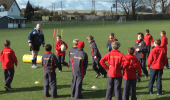 2:15
2:15
Passing - 3 v 2 Live Defenders
Gradually progress from 2 static defenders, to 3 v 2 roaming defenders. The first two players must draw their defenders before giving the pass.
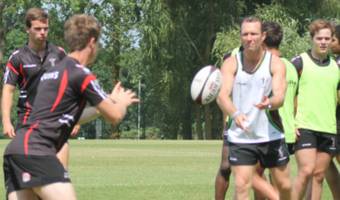 3:05
3:05
3 v 2 How to Fix Defenders
Running straight & fixing defenders is a skill that all players must learn and learn at an early age. The top players regularly practise this skill to maintain accuracy. This is the building block to scoring tries
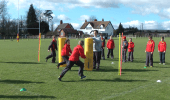 1:16
1:16
Passing - 3 v 2 Static Defenders
Progress to working in 3s against two static defenders. The pressure is on the middle player to hold their depth and perform a quick pass.
To watch over 2500+ videos join now for free!
JOIN NOW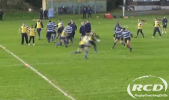 0:46
0:46
3 v 2 and then another defender
Develop decision-making skills in attack. 3 attackers must beat 2 defenders, before facing a third immediately after.
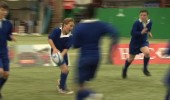 0:26
0:26
3 v 2 in Channel
A development of the 2 v 1 and 3 v1 drills, the attackers now must beat 2 defenders. This requires more decision-making ability as the movements of the defenders could change every time. Players must communicate as well as continue to perform their handling and running skills.
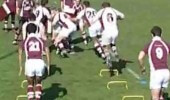 0:21
0:21
6 v 2 v 2 v 2 v 3
Developing the skills into decision making down a channel
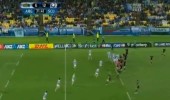 0:19
0:19
Men's - 3 v 2 1
A passage of play that shows how to attack with more attackers than defenders, a 3 v 2. The winger shows that strong running and determination can break tackles. Click on the practises in this section for coaching ideas
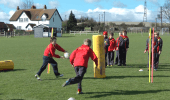 1:02
1:02
Passing - 2 v 1 Static Defender
Now working in just twos, we are concerned with depth, and the timing of the pass. Allow players to practice before adding a static defender. This can be a tackle bag as demonstrated. Players take the ball up to the defender but must complete the pass before they reach it.
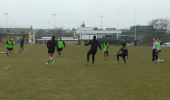 2:59
2:59
Quins Defence - Tackling in units 3 v 3
This exercise is part of a tackle technique progression and pitches 3 attackers v 3 defenders. As in match play the attacking players will present different challenges to the defenders. The coaches can choose to alter the conditions to put more or less pressure on the players
 0:15
0:15
Women's - 2 v 3 1
Women's - 2 v 3 1
11. 6 v 2 v 2 v 2

Women's - 2 v 3 2

Junior - 3 v 2 2
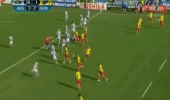 0:20
0:20
Men's - 3 v 2 2
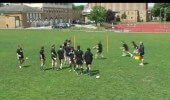 0:33
0:33
3 v 2 in channel
A good progression from the 2 v 1 drill
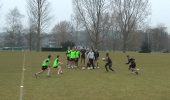 2:59
2:59
Quins Defence - 2 v 2 tackling
A progression from the 1 v 1 drill this exercise adds extra players to make the decision making process more realistic. The coaches can vary the delivery of the ball and the width of the area to put different conditions to the players
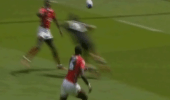
Sevens - 2 v 1
A variety of passes create a 2 v 1 which is executed perfectly for the outside attacker to score. Key factors : Different angles of running and support - Comunication - Ball presentation - Effective clearing of defenders at the breakdown - Accurate wide passes - Attack the inside shoulder of the last defender - Flat spin pass
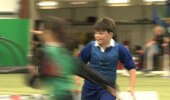 0:28
0:28
2 v 1 Draw and Pass
A basic 2 v 1 drill that encourages players to time their pass after they have drawn a defender, and for the supporting player to hold their depth.
Step 4 - Introducing the 2 v 2 Scrum
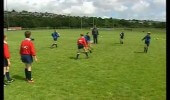 0:15
0:15
Introducing live defenders for 2 v 1
Developing passing skills with more pressure and intensity
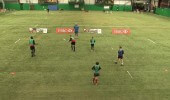 0:28
0:28
3 v 1 in Channel
A progression from the 2 v 1, where a second pass is encouraged to move the ball away from the defender.

Women's - Accurate clearing of players 2
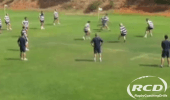 1:19
1:19
3 v 2 attacking practice
A useful drill to build decision-making skills. Attackers must choose from a variety of running and passing options.
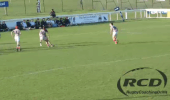
Sevens - 2 v 1
Having identified a 2 v 1 situation, the RGS Guildford player decides not to give an early pass from the breakdown, but instead to run and commit the defender before giving a pass to his teammate. Key factors: Timing - communication - accurate passing

Men's - Accurate clearing of players 2

Sevens - Accurate clearing of players 2

Junior - Accurate clearing of players 2

Women's - Accurate clearing of players 3

Junior - 3 v 2 1
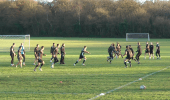 1:43
1:43
Broncos 4 - 6 v 3 Identify space
Players to attack with "Heads up" and identify where colleagues have space. Supporting players to call early to the ball carriers. Defenders to stay tight to not let attack through the middle spaces easily
Step 5 - Introducing the 3 v 3 Scrum
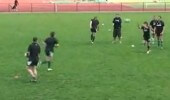
Passing 4 v 3 reset
A progression from 2 v 1 , 3 v 2 to 4 v 3
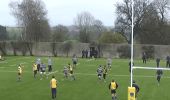 1:00
1:00
Attack Grid - 4 v 2
This continuous exercise puts pressure on your players to think fast and be ruthless in attacking the space. Coaches can change the size of the grid and the number of defenders to make it an easier game
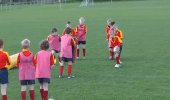 1:49
1:49
2 v 1 Passing
Adding a live defender helps to encourage players to hold their depth in support, so a good pass can be completed.
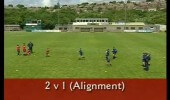 0:15
0:15
2 v 1 with withd & flat pass
These are core skill drills for youngsters to learn the game. As a coach you can alter the width and depth of the supporting players
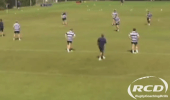 0:51
0:51
Attacking progression's 4 v 3
A progression from 3 v 2s, this drill is closer to a game situation, where there are more decisions for the attacking players to make. The gaps could appear in a variety of locations and they have several passing /running options. With 4 attacking players, you may wish to utilise your basic strike moves.
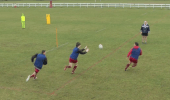 5:22
5:22
Passing Progressions with defenders
Use progressions to change the pressure points so that players are taken "Out of their comfort zone" and experience more match related situations. Rugby is about creating a 2 v 1 opportunity so fixing defenders is one of the most important skills to learn
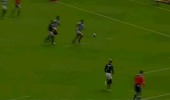
Sevens - 2 v 1
Seven's is about creating chances and then taking them. In this clip the Blue team take the ball up the middle of the pitch to draw in defenders, after recycling the ball they have a 2 v 1 opportunity, a straight line of running and a flat wide pass creates the try. Key factors : Call early - Run straight - Wide spin pass - Catch and swerve to score
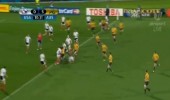 0:17
0:17
Men's - 2 v 1
A good example of phase play to create a 2 v 1 attacking platform. The initial deep pass then creates an overlap and the defender drifts to allow the attacker to run through easily.
Key factors : Quick ball at breakdown - Straight lines of running - Deep pass - straight lines of running again - Loud communication
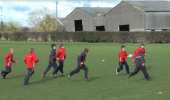 2:28
2:28
Conditioned Touch - Linked defenders
In this game, two defenders must link up, slowing them down and creating more opportunities for the attacking side. This can create the overlap necessary to put 2 v 1 and 3 v 2 techniques into practice.
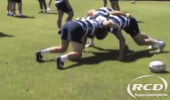 0:53
0:53
Scrum Technique 1 v 2
This drill acts as a warm up for the single player, with the other two simply providing resistance. The single player must maintain a strong body position and push the other two backwards.
11. 4 v 2 Continuous Touch Rugby
 0:23
0:23
Junior - 2 v 1 2
Junior - 2 v 1 2
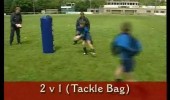
Learning to pass 2 v 1
Developing lines of running to attack the inside shoulder of defenders
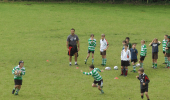 1:00
1:00
Attack 2 v 1
A good decision-making exercise which requires players to practice their basic running and passing skills
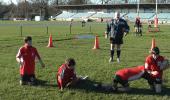 0:37
0:37
Tackling on Knees - 3 v 1
Using three attackers ensures the defender tackles on both sides and from slightly different angles. The coach can vary the pace and width of this exercise
Step 3 - Introducing the 1 v 1 Scrum

Sevens - 2 v 1 2
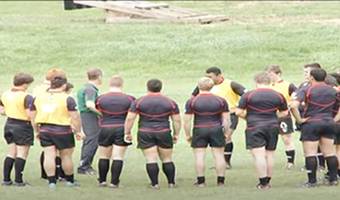 2:16
2:16
L2 - Outflanking Game
Skill Practice Description The objective of this game is to develop the ability to execute the 2 v 1 with consistent efficiency. • The attacking team initially has at least one extra players in order to create an advantage. • There is a channel on each wing in which only 1 defender and 2 attackers may enter at any time. • The attack works the play to get the ball into the outside channel then execute the 2 v 1. • With the extra players, the attack can also develop opportunities to penetrate the defence and so the game in not relying on lateral moment and still incorporates the principles of ‘go forward’. • The progression is to remove the cones and see if the players can still take advantage of the 2 v 1 without the conditions set within the channelled areas . • A further progression would be to even the numbers of each team. Key Coaching Points • Running lines to condense and hold defences in order to outflank. • Running lines in order to disrupt and penetrate the defence line. Relevance to the Game • Attacking players often fail to fix defenders effectively and may drift or over elaborate. • This game will assist in angles of run that fix the last defender

Women's - 2 v 1
Women's - 2 v 1
 0:42
0:42
Junior - Accurate clearing of players 1
Junior - Accurate clearing of players
 0:25
0:25
Junior - 2 v 1 1
Junior - 2 v 1 1
2-man Tackle and Decision-making
This practice develops communication in a three v three game format
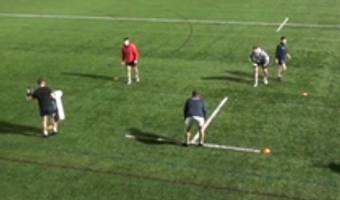 1:06
1:06
Contact Square - Inside Clear
All attacking players need to fix their opposite defender.
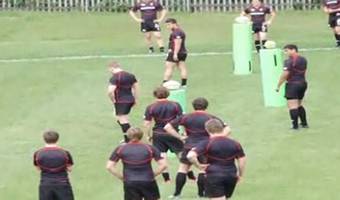 2:53
2:53
L2 - Conditioning Circuit
Using the full length of the pitch the practice is a continuous 3 v 2 scenario. • 3 attackers knock over a bag to collect a ball and attack 2 defenders in the 5m channel. • If they fail to beat the defenders (touch/grip), the attackers run back to knock over another bag and start again. • Having beaten the first defenders they carry on with the same ball to beat 2 further defenders who may choose a colour and start from the appropriate cone. • If the attackers fail to beat the defence they run back to the bag and start again with another ball. The defence can choose another colour to start from. • The next challenge is two free roaming defenders. If the attack fail they go back and knock over another bag to start again. • Finally the defenders choose a colour to start from and if the attack fail they get another ball and the defence choose another starting colour. • The objective is to complete the attack with the starting ball and restarts. Keep score to create competition
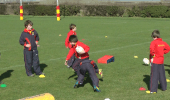 2:24
2:24
1 v 1 Tackling in Channel
An opportunity for players to put what they have learnt on tackle technique into practice. Each tackle is observed by all other players who can give feedback. Ensure all players have a go at attacking and defending.

Men's - Injured players and medics 2

Junior - Support player / Leach 2
1. Support - 1,2,3 Follow Through
Isolated technical practice
Courtesy of the SRU
Level 2 - Back Row Example Clip 3
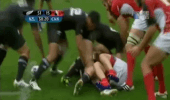
Men's - Accurate clearing of players 1
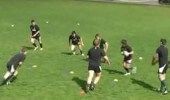
4 v 3 after 5m reset
Core skills training

Women's - Accurate clearing of players 1
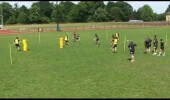 0:54
0:54
Change the point of attack - 4 v 3
This drill allows you to develop decision making by varying the attack and defence continually thus accelerating learning
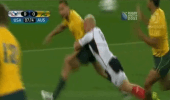 0:15
0:15
Men's - Offloads 2
A counter attack invlving moving the ball wide quickly, then attack defenders with support runners and finally a 2 v 1 to score in the corner. Key factors : Strong communication - Wide spin passes - Attacking the space around defenders - Support the ball carrier from behind - Offload with two hands - straight running - Flat pass
Small -sided game - 5 v 3
This is an intuitive decision-making pratice

Sevens - Accurate clearing of players 1
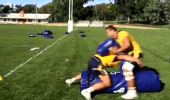 8:10
8:10
Ruck Clearing and Decision Making
Advanced clearing exercises for senior players. The support player makes a decision on how to clear out the ruck based on the position of the opposition.
 0:54
0:54
Attacking progression's 5 v 4
Progressing from 3 v 2s an 4 v 3s, you can now attack with something resembling a full back-line. Give the defence different instructions each time to test the reactions and decision-making skills of your attacking players.
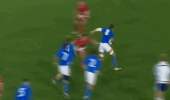 0:40
0:40
IRB Men's - Offloads 3
A quick lineout allows players to attack a "broken field" defence. Running at space moves the defenders and the suport player comes from depth behind the attacker to score. Key factors : Loud communication - Accurate spin pass - Attacking space - Trail support - Pop pass - Quick running
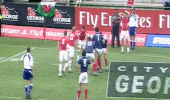 0:38
0:38
Sevens - Full Lineout 3
Accurate skills are the key to lineouts in seven's, a combination of movement, lifting and throw combine to make an effective restart for the attacking team. The shape of the attacking side is pre planned to create a mis - match with a faster player v a slower one. key factors : Pre call the move - Fast feet - Strong core for jumper - Support from both players to lift the jumper - Jumper to jump - Accurate throw - Support he jumper to the ground - Offload pass to scrum half
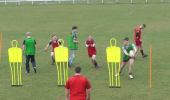 6:32
6:32
Fixing Defenders
Starting with a simple 3 man passing drill the coach adds pressure adding fixed defenders and then live defenders, the progressions are intended to be game related. Ask questions to confirm technical points
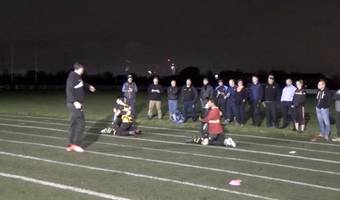 3:46
3:46
Functional Movement Warm Up Part 2
Every player should be able to perform these movements well! Mastering these will carry over to preventing injuries, managing collisions and maximising power and speed. Check out the related videos for part 1.
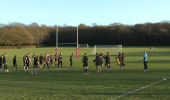 2:02
2:02
Broncos 3 - Develop waves of attack
The first wave of attackers identify space and punch through the first line of defence. The ball carrier looks to move the ball quickly and away from covering defenders. This exercise tries to copy game situations as players cover their team mates in defence
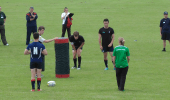 1:27
1:27
Turnover session - Clearing
Breaking down the turnover situation into separate technical elements, players can work on their essential skills.
Here, in a series of progressions, the emphasis is on the first defender to arrive at the breakdown. They should attack the breakdown and fight to get through and past the ball.
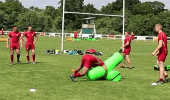 4:55
4:55
Ruck Clearing Exercises
Two crucial clearance techniques - the saddle roll, and the duck and clean. It's important for players to practice these at length, under pressure, under fatigue, and with an element of decision-making in order to best re-create a match situation.
 5:13
5:13
Ball Retention Techniques
Progressions are used to build the technical competency and the confidence of players learning to clear defenders away from the contact area. It is interesting to see that no contact shields are used
 0:08
0:08
Defence - 3. Press Up and Out
This illustration is an up-and-out system and not a drift
This relies on the defenders continuing to press forward, closing the space as they shadow the attacking players
CCRU Game - Piggy in the middle
Description of activity: In groups of 3 v 1 the three attacking players have the ball and pass it around to each other trying to keep it from the defender. Give the attacking players a target i.e. make 10 successful passes. The defender tries to either intercept the pass or force a poor passes where the ball goes to the ground or outside of the marked area
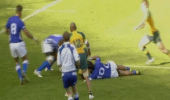 0:59
0:59
Sevens - Turnovers and move the ball 2
A turnover from a strong tackle and quick "Jackle" where the defender uses the momentum of the attacking player to swimg up onto his feet and contest the ball, this results in a line break. Key factors : Tackle technique - Urgency to get up to feet - Core strength - Speed
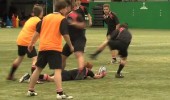 0:46
0:46
6v4 Touch (2)
A simple game of touch rugby with more players on the attacking team, and the defenders are required to retreat 5m after each touch. This should give more opportunities to the attackers and promote quick decision-making.
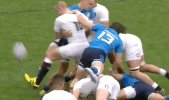 3:27
3:27
Breakdown - Clear & Kick
Teach your players how to kick the ball at the ruck. With players sometimes reluctant to give away penalties this technique is a great way to turnover the ball and stay on your feet
L2 - Support Line Breaks
Skill Practice Description • The objective is to increase the commitment to supporting a line break. • The teams play continuous touch, grip or tackle. • Stage 1: when a score is made all attacking players must touch the try line within 3 seconds or the try is disallowed and a turn over is awarded. • Stage 2: when a try is scored all attacking players must touch the ball on the ground within 5 seconds or the try is disallowed and a turnover is awarded. • Play starts again direct from the try line. • The coach may split the defence so cover defenders can challenge the effect of support play once the first line has been breached. Key Coaching Points • Encourage supporting players to angle toward the line break and not stay wide and lateral. • Encourage all attacking players to react and support a line break. • Speed of reaction. • Communication and team work
3. Ruck Touch
 1:32
1:32
Quins Defence - 1 v 1 tackle skills
Close contact in a small channel ensures the players work their movement skills in both attack and defence. The coach reinforces the skills for contact prior to progressing this exercise
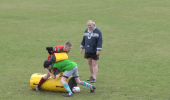 6:38
6:38
Breakdown - Coaching Players To Make Decisions
The coach uses a combination of drills & games to deliver a session on making decisions at the breakdown. There are some technical points and observations on the coach using classic "Tell & Yell" instructions
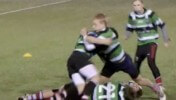 3:31
3:31
Ruck touch - Focus on rolling players away
A key technique at the breakdown is the ability to roll players away, this applies when your opponent already has a good body position over the ball. Danny Wild from Leeds carnegie uses a game and breakout sessions to deliver his session
Tackling 2 - Rugby Kibadi
 4:08
4:08
Stop Your Players Crabbing Sideways
Successful rugby requires players to run straight and fix defenders. This is a constant challenge to coaches and new ideas and exercises can freshen up your training sessions, this clip has two practises along with some advice from elite coaches
Level 2 - Scrum Body Positions
Level 2 - Scrum Body Positions
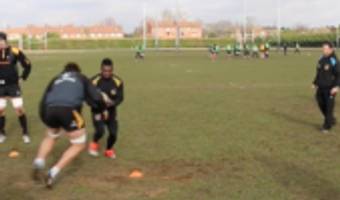 2:18
2:18
Tackling 20 - 2-man Tackle
Tackling 20 - 2 man Tackle
 2:16
2:16
Worcester - Decision Making
The coach uses a tackle sausage and ball to replicate an attacking player. If the player falls back towards the defender he secures the ball, if the attacker falls further away the defender clears aggressively. This exercise could be worked as a support player for one of your own attackers

Men's - Full lineout 2
A 5 man lineout where all the players are spread evenly apart, all players can lift and jump so the focus is on speed and accuracy. Key factors : Even spread of players - Communication - Quick jump - Accuate lifting - Accurate throw in
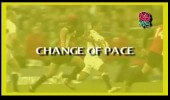 0:35
0:35
Beating defenders with speed
Changing speed is a skill which all players should understand
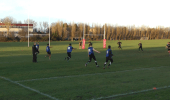 0:59
0:59
Broncos 6 - Attack to Defence 8 v 5
A combination of skills are tested, both technical and tactical with the defenders moving from a passing activity to defending 8 attackers. The coach can change the attack with different starting points and number of attackers
Scrum Factory - 2. Tower of Power Demonstration
Good body posture is essential and applicable to all players regardless of age and gender
This posture transfers to the tackle, ruck, maul and in a vertical plain the lineout, so it is important that all players are coached to adopt good posture in contact
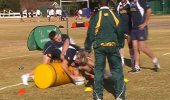 0:55
0:55
Breakdown - Grip and Roll (Saddle)
The grip and roll clearing technique, (Known as saddle clearing to some) is a technique to use when defenders have already established a strong position over the ball. Using brute force will probably fail so approaching the defender slightly from the side and using the clearers momentum he grips and rolls the player away
 3:53
3:53
Coach Player Rapport
Do you understand the significance of 'Rapport" and how this can influence how good a coach you are. Elite coaches, experts and pundits provide a clear view of how important this is
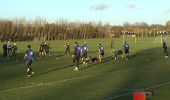 1:41
1:41
Broncos 5 - 2 Ball touch to test the defence
This exercise tests the defenders ability to keep a peripheral view of where the next threat might be coming from and to keep communicating with colleagues. Attackers are always looking for the next opportunity an so should defenders
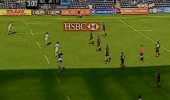 0:24
0:24
Sevens - Offloads 2
To execute an offload you need to have support players in the right area, here the ball carrier knows he has support and is able to take a risk and offload out of the back of the tackle. Prior to the offload the ball carrier works hard to stay on his feet. Key factor : Leg drive - Twist and work the body in contact - Control ball one handed - Communication from support players

